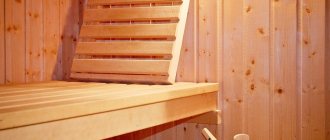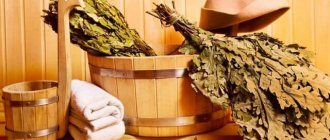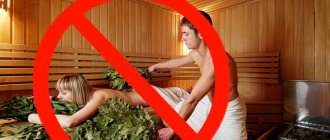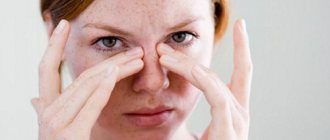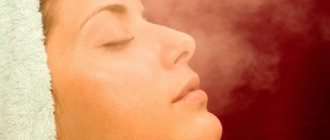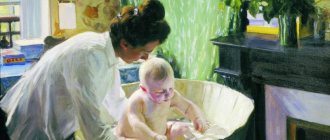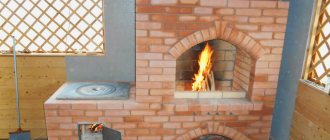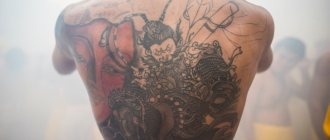From time immemorial in Rus', women gave birth in a bathhouse (and not only commoners, but also noblewomen, princesses and even queens).
By the way, modern medicine, as often happens, has confirmed that our ancestors had many reasons for this. There is a lot of warm water in the bathhouse, the right air temperature (which is suitable not only for the mother in labor, but also for the newborn baby), and hot steam kills pathogenic microbes. And from birth, the bathhouse accompanies a person all his life - the bathhouse soars, the bathhouse rules, the bathhouse will fix everything, people say.
What types of baths are there?
There are countless of them - Russian, Finnish sauna, oriental (Turkish), Roman thermal bath, Japanese ofuro and even exotic ones like sand saunas. But all these types can be divided into two large groups: dry and steam. The classic type of dry bath is the Finnish sauna (the air in it warms up to 90-120 degrees, and the air humidity is 10-15%). An example of a steam bath is a Russian bath; it is not so hot, but much more humid: the temperature in such a bath usually reaches 40-60 degrees, and the humidity is up to 90%. As a rule, a dry bath is much easier to tolerate. So we recommend that beginners start with it.
What temperature is allowed in the steam room for children?
You also need to gradually accustom your child to the hot temperature in the steam room. On your first visits, enter the steam room when it has cooled down - no hotter than 40 degrees. As the child gets used to it, you can increase the temperature to 50-60 degrees. It is not recommended to enter the hotter steam room with children under seven years of age. Bring a towel or diaper with you for your baby to sit or lie on. His place is on the bottom shelf, where it is cooler and safer.
After the steam room, the child can take a warm shower, perhaps alternating it with a cool one, but under no circumstances should the child be doused with ice water or wiped with snow.
When to start
It is best to get acquainted with the bathhouse before the baby is conceived. Moreover, obstetricians and gynecologists came to the conclusion that the bath is indicated for infertility, ovarian dysfunction, amenorrhea, and chronic diseases of the internal genital organs.
You can go to the bathhouse during pregnancy. For expectant mothers who have visited the sauna, childbirth is easier and less painful; they require antispasmodics and analgesics much less often during childbirth. This is due to the fact that regular visits to the bathhouse increase the elasticity of the ligamentous apparatus, reduce excessive muscle tension, and have a positive effect on the nervous autonomic system.
However, before your first visit to the bathhouse, you should consult your gynecologist. After all, the bathhouse also has some contraindications. These include: acute inflammatory diseases, conditions after surgery, complicated pregnancy.
If you have no contraindications, you can safely go to the bathhouse. Just keep in mind that if you didn’t go to the bathhouse before pregnancy, then for the first time you need to do it with some caution, carefully listening to your own feelings. Don't sit in the steam room for a long time, try to rest as much as possible. If anything in your condition worries you (dizzy, nauseous), immediately leave the steam room.
Contraindications
You should not resort to the help of a steam room if the child has disturbances in the functioning of vital organs and systems. The following are contraindications:
- Malfunctions of the heart and blood vessels, with or without the development of characteristic symptoms.
- Pathologies of the nervous system, high intracranial pressure, the presence of brain cysts.
- General weakness of the body, unpreparedness for changes in temperature conditions.
- The presence of diseases of viral, cold or infectious origin.
- Skin infections, furunculosis, dermatitis, eczema, diaper rash.
- Diseases of the respiratory system.
When visiting the bathhouse, the child should not experience any unpleasant phenomena. His skin is pink in color, sweat is allowed, but it is moderate in nature. If the baby sweats profusely, it is better to take him out of the steam room, as there is a risk of dehydration.
If the baby's skin changes color - it becomes blue or too pale - immediately leave the steam room and monitor the condition. If necessary, call an ambulance. When it comes to a bath and a child in his first year of life, you should be careful. Such procedures can cause overheating and negatively affect the baby’s health.
Baby's first bath
It has been noticed that children who have “visited” the bathhouse while in their mother’s belly perceive bathing procedures much more easily after birth. After all, for nine months they had already been steaming, dousing themselves, and relaxing with their mother over a cup of aromatic tea. Only now these sensations have become much brighter.
If the mother regularly went to the bathhouse during pregnancy, a “real” meeting of the baby with the bathhouse can be arranged when he is three months old. A.D. Timofeeva, a famous naturopathic pediatrician, author of the book “Conversations of a Children’s Doctor,” believes that it is better to postpone acquaintance with the bathhouse until 7-8 months.
But it must also be prepared.
The fact is that the delicate skin of a newborn baby is not yet accustomed to temperature changes. To make the adaptation process more intense, you can practice air baths from birth. When changing your baby's clothes, don't rush. Let him lie naked for a while, bouncing his arms and legs.
And when you bathe your baby, prepare in advance in a separate basin a little colder water than the “main” bath. You can even simply pour the bath water into a basin before bathing. While the young swimmer is splashing around in the bath, the water in the basin will have time to cool down a couple of degrees.
Many apologists for “natural development” insist on immediately pouring cold water over the baby. But this question is very individual. Try it, maybe this method will suit you and your baby. However, be honest and consistent: you have the right to douse your child only if you douse yourself with ice water. You can even do this together - you undress, stand in the bath with the baby in your arms, and dad or a particularly brave grandmother pours a bucket of cold water on you in one fell swoop. The baby, of course, will scream from such a temperature difference (after all, just like an adult, it takes your breath away). But then you wrap him in a warm towel, put him on your chest, and he should immediately calm down.
I can say that even in the same family, this method suits some, but not others. For example, my eldest daughter happily doused herself and together with me came up with a fairy tale about the Cold Waterfall, but my youngest daughter categorically did not like this procedure. If the baby does not agree to dousing in any way, do not insist, because the baby also has the right to vote.
And to adapt the skin to temperature changes, simply cool (not ice) water and air baths are quite suitable. If your treasure reacts positively to undressing and dressing (remaining naked, the baby does not cry, does not shrink, his skin does not turn blue or pale, his chin does not tremble), then we will assume that he is already quite ready for the first meeting with the sauna. Tune in to the fact that everything will be fine, and your emotions will definitely be transferred to the baby.
What is strictly prohibited after implantation
Despite the abundance of recommendations, there are a number of things that are strictly prohibited, these are:
- smoking and drinking alcohol;
- taking medications that were not prescribed by the doctor;
- eating hard foods - nuts, seeds, crackers, snacks;
- Do not touch the operated area with your hands or tongue, especially on the first day after the procedure;
- refuse medications prescribed by a specialist - antibiotics are usually prescribed; they prevent inflammatory processes and implant rejection;
- brushing your teeth with a hard brush;
- hard physical work and sports.
If you follow these simple rules, recovery after implantation will take place without complications, and the implant will take root safely. Otherwise, you can provoke complications, including inflammation and rejection of the artificial tooth, which is fraught not only with repeated surgery, but also with additional costs and loss of time.
Madonna and Child in the sauna
The best way to experience a sauna is in your mother's arms. And even better - at my mother's breast. This is the most powerful sedative. In addition, it was found that lactation increases in 80% of nursing mothers in the sauna. On your first visit, spend literally one minute in the sauna.
Carefully monitor the fontanel; under no circumstances should it be allowed to swell. A normal reaction to increased temperature in the sauna: slight sweating, pink (not red!) skin, good health, the baby does not turn pale, does not cry.
Immediately after warming up, be sure to pour water over the child (it would be good to prepare it in advance before entering the steam room). If you are not a supporter of extremism, then the water does not have to be icy. Even if it is just at room temperature, the temperature contrast after the steam room will still be noticeable. This is not only a hardening, but also a hygienic procedure, because you need to wash away sweat and toxins from the skin, then it will be easier for it to breathe.
And now you can relax - sit together, wrapped in a towel, drink tea or splash in the pool.
These three phases - steam room, cooling, rest - are the main components of the bath ritual. It is in this sequence that they are repeated as many times as you feel comfortable with. Usually, for the first visit, two or three visits to the steam room are enough. Over time, the baby will get used to longer stays in the sauna. But don't rush it just yet!
Rules for bath procedures
Health procedures in a bathhouse with children require compliance with important rules that will protect children from unpleasant consequences:
- Children over 3 years of age can take procedures independently or under parental supervision, infants and children under 2 years old - only in the presence of their mother. The child sits on the lowest shelves.
- After leaving the steam room, children should not be sharply cooled with a contrast shower or water in the pool. The best option is rinsing with warm water and dry rubbing.
- The procedures are carried out using bath shoes and a hat worn on dry hair.
- If signs of heat stroke are detected or the baby is not feeling well, immediately take him out of the steam room to a room with a lower temperature and good ventilation.
- In order for a bathhouse for a child to become a good disease prevention, it is necessary to adhere to the regularity of the procedures - no more than once every 7 days, if the baby tolerates high temperatures and air humidity well.
- Before the first visit to the steam room, the baby’s body does not need to be rinsed, and after the procedures it is necessary to wash thoroughly under a warm shower using baby cosmetics.
- Visiting the bathhouse should not be done on an empty stomach or after a heavy meal. After all procedures, drinks, fruit and milk snacks are allowed, and a full meal is allowed after 2.5 hours.
- Between visits, the baby should be given plenty of fluids - fruit juices, berry fruit drinks, weak teas or clean water.
Particularly important is the temperature regime in the steam room, which is set taking into account age restrictions:
- for infants up to 1 year – no more than 50 degrees;
- for children from 2 to 3 years old – 60 degrees;
- for children from 4 to 7 years old – up to 65 degrees (in 2 passes of 2.5 minutes each);
- for children from 8 to 12 years old – up to 70 degrees (in 2 passes of 5 minutes each);
- for teenagers from 13 years old and above - up to 80 degrees (in 2 passes for up to 10 minutes).
When visiting a sauna with children, you need to monitor the length of their stay in the steam room to avoid heat stroke. You can use a stopwatch for this.
Long breaks must be taken between individual visits to help young visitors adapt to the climatic conditions of the steam room.
During breaks, you can pour warm water over them, give them water or fruit drink.
When carrying out health procedures with children, parents can use a bath broom slightly warmed with hot water.
The broom massage procedure itself is carried out in smooth circular movements with light tapping. In this case, special attention should be paid to the baby’s back and feet.
The train left?
If you did not go to the bathhouse during pregnancy or your child has already left the tender age of infancy, do not think that now everything is lost. It's never too late to start!
Each age has its own characteristics of sauna trips.
Never carry a baby who can already walk into the steam room in your arms. This is an important psychological moment. On the one hand, mother’s hands provide, of course, protection, but on the other hand, for a child who craves independence, this is some kind of violence. Open the door to the steam room, go in there and invite your child with you. Let him come in on his own.
If your child is over three years old, be sure to tell him what awaits him before going to the sauna (however, this note applies to children of any age). Come up with a fairy tale about a hot African country where you will go on a trip. And then you will need to stand under the Ice Waterfall or dive into the “hole” of the cold font. And then - relax and drink a special heroic drink (rosehip decoction or cranberry juice).
Lifestyle: do's and don'ts after dental implantation
In general, installing implants is not a reason to give up your usual lifestyle. However, there are still a number of limitations:
- complete cessation of smoking, alcohol, coffee, sweet soda;
- refusal of sports training - cardio and strength training, active running, squats and other exercises;
- visiting a sauna, bathhouse, taking a hot bath, or prolonged exposure to heat and sun is completely prohibited;
- staying in the cold for too long;
- for the first few weeks you need to give up swimming, both in the pool and in open water;
- it is necessary to avoid drafts to prevent colds - during the rehabilitation period it is extremely undesirable to sneeze or blow your nose, this can lead to displacement of the implant.
General mobility, on the contrary, should be increased; walks in the fresh air will also benefit. On the contrary, you cannot spend a lot of time lying down.
To speed up healing, you can take vitamins and mineral complexes.
A bath will fix everything
If your baby is suffering from colds, we highly recommend that you think about a bath. It strengthens the immune system, trains the cardiovascular system, and promotes the removal of mucus. And in the steam room you can breathe in the steam from herbal infusions (eucalyptus, linden, chamomile, etc. are suitable), here you have inhalation. The bath is also indicated for diseases of the skin, as well as the musculoskeletal system.
A bathhouse is useful for children with hypertonicity, because during bathing procedures muscle tone decreases, nerves calm down and overall well-being improves. Alternating temperatures initially gives a feeling of vigor, which is then replaced by relaxation and a feeling of pleasant fatigue. Tested: after the bath, children fall asleep right on the way home and sleep unusually soundly!
But the bathhouse also has contraindications. As for pregnant women, these are, first of all, acute inflammatory diseases accompanied by high fever. A sauna or bath is strictly prohibited for purulent inflammatory and infectious diseases (otitis, sinusitis, furunculosis), even if the temperature is not elevated. But if this disease is in a chronic stage, then a bath is very welcome.
You should not visit the bathhouse if you have convulsive seizures of various etiologies or with any form of epilepsy.
And one last thing. The effect of a bath or sauna will only be if you visit it regularly with your baby. Let this become your pleasant and at the same time useful habit!
Inessa Smyk
How to eliminate pain without harming your health
Pain and swelling in the first few days after surgery is normal. To relieve pain, you can take painkillers. These are non-narcotic analgesics, but the specific drug is prescribed by the doctor, taking into account the clinical picture and individual characteristics of the patient. Prescribing painkillers for yourself is strictly prohibited.
Additionally, you can apply a cold compress to your cheek - a heating pad with cold water or ice. But you can do this for no more than 10-15 minutes with a break of 40 minutes. You cannot hold the compress longer, so as not to provoke hypothermia and inflammation.
Rinsing the mouth with a special solution will help relieve or reduce pain; which drug to use should be checked with the specialist who performed the implantation.
To speed up the healing process, you can apply a healing ointment to the operated area.
The use of herbal infusions and decoctions is allowed, but only in consultation with the doctor, since individual components can cause allergies and other reactions. The compositions are used for rinsing the mouth along with antiseptic solutions.
